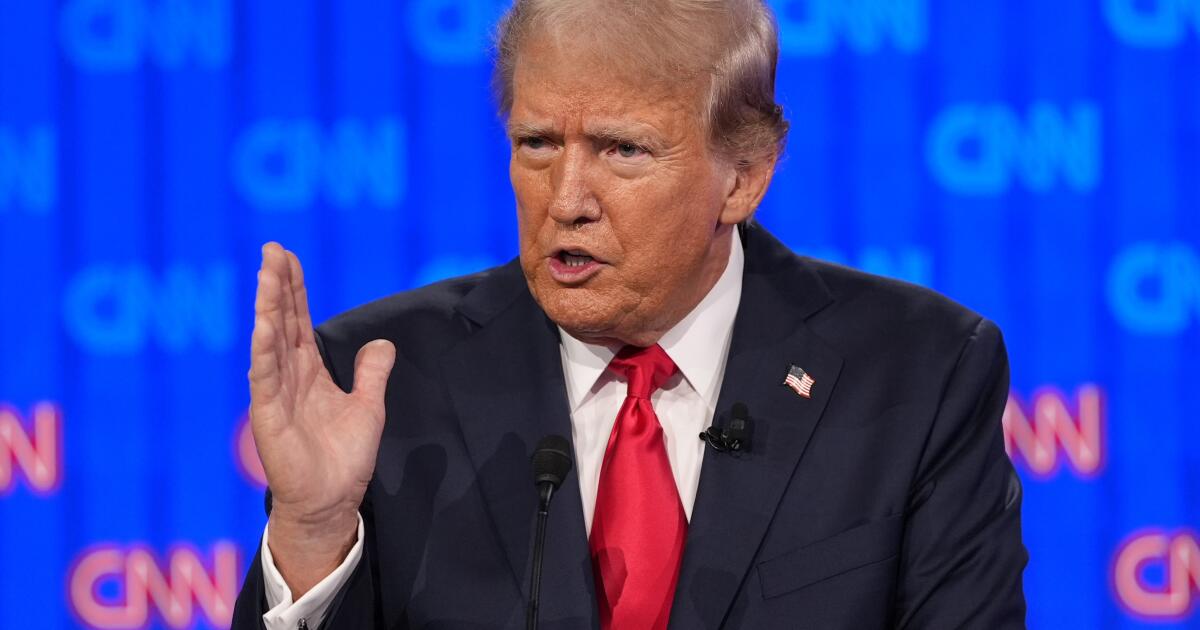Business
'Erewhon 2.0' is coming with three new locations opening in 2025

Erewhon, the luxury supermarket chain that turned grocery shopping into a hyper-trendy Los Angeles lifestyle, is ramping up its pace of expansion.
The company will move into three cities in 2025: Manhattan Beach, West Hollywood and Glendale.
It’s the most store openings in a single year since owners Tony and Josephine Antoci bought Erewhon in 2011, a sign of the organic grocer’s soaring popularity. And after relocating its central kitchen to a much larger industrial space last month, the company says it has the capacity to grow even more around Southern California.
“We see 2025 as the beginning of Erewhon 2.0 — a wave of expansion for us,” said Tony Antoci, who is chief executive.
In Glendale, Erewhon will be taking over the property previously occupied by Virgil’s Hardware Home Center.
(Gina Ferazzi / Los Angeles Times)
The Manhattan Beach store will be Erewhon’s first in the South Bay and is scheduled to open in March in a former Mother’s Market & Kitchen at 1700 Rosecrans Ave. After that, the West Hollywood store is set to open over the summer at 8550 Santa Monica Blvd. in a space that was previously a Sprouts. The Glendale store is expected to open toward the end of the year at the site of the old Virgil’s Hardware Home Center at 520 N. Glendale Ave.
Erewhon currently operates 10 markets, all of them in affluent areas of Los Angeles County. Its Pacific Palisades store, which survived the Palisades fire, is temporarily closed.
To support the addition of three new locations — and particularly the in-store cafes that have become core to Erewhon’s business — the company recently completed a three-year buildout of a new central kitchen in Vernon, which at 65,000 square feet is five times larger than its previous one in Boyle Heights.
Known as the commissary, the kitchen is where all of Erewhon’s TikTok-famous hot bar and tonic bar menu items — buffalo cauliflower, coconut chicken tenders, kale salads and gluten-free coconut chaga brownies — are prepped before being delivered to its grocery stores around 5 a.m. daily.
Unlike at traditional supermarket chains, Erewhon has cultivated a following of shoppers who visit daily to grab a prepared meal or one of its celebrity-backed $20 smoothies. The privately held company declined to share financial figures, but said its all-day cafes take up roughly 30% of floor space and serve 100,000 customers every week.
In a 2021 interview with The Times, Tony Antoci said about 40% of the company’s revenue came from its prepared foods and private-label products. Erewhon reportedly pulls in $1,800 to $2,500 in sales per square foot; the industry average is $500 per square foot.
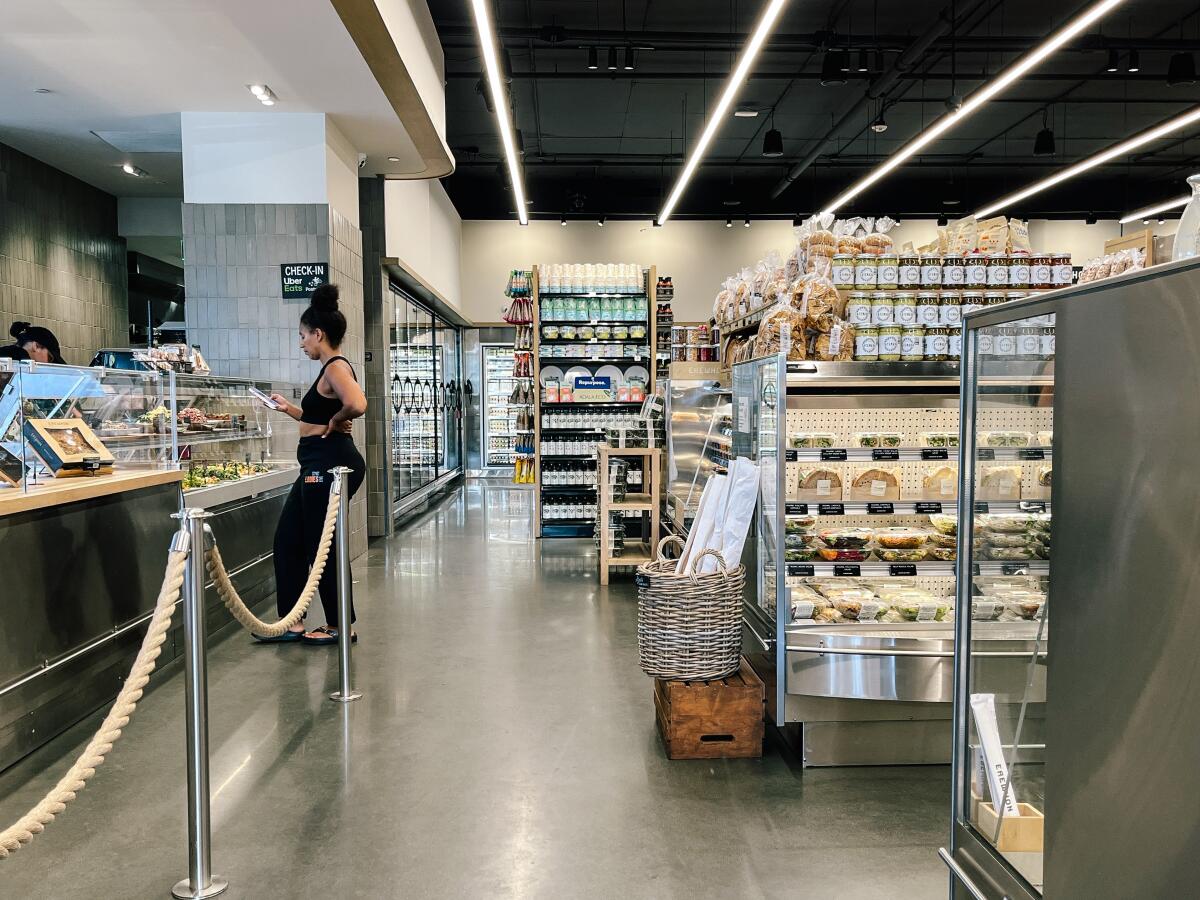
A customer orders from the cafe at Erewhon in Culver City in July.
(Dania Maxwell / Los Angeles Times)
As Erewhon has increased its footprint around L.A. County, it has expanded and relocated its commissary every few years to keep up.
Roughly 350 of Erewhon’s 2,500 employees work out of the new 110,000-square-foot Vernon building. The commissary takes up more than half of the leased space and includes a bakery, juice room, pasta room, dry storage and production areas, a research and development kitchen and a training kitchen for the stores’ culinary managers. The rest of the building is being used as office space.
“It’s raising the ceiling of what we can accomplish,” said Tony, who called the commissary the “engine” of the business. “That means more variety, more consistency and more innovation.”
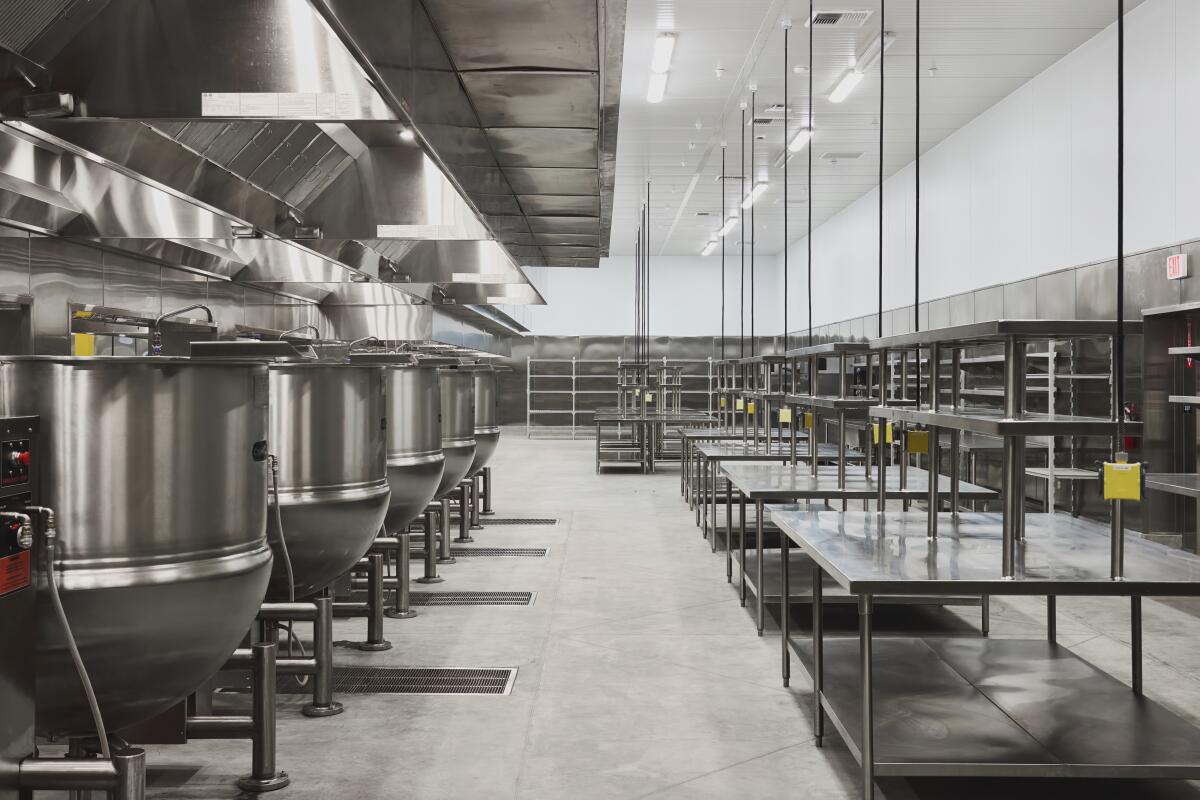
Erewhon’s new commissary, where all the food for its cafes is prepped, takes up 65,000 square feet in Vernon and includes a bakery, juice room, pasta room and dry storage warehouse.
(Andrew Kenney)
Erewhon didn’t start out as a premium grocer. It was founded in 1966 by Japanese immigrants Michio and Aveline Kushi, pioneers of the natural-foods macrobiotic movement who began selling imported organic goods such as brown rice, miso, soy sauce and umeboshi out of their Boston home. After the health department shut it down, the couple rented a small storefront nearby and named it Erewhon, an anagram of “nowhere.”
Erewhon grew to three stores and a distribution facility on the East Coast, and in 1969, the company opened a location in L.A. on Beverly Boulevard. The stores changed owners several times, and eventually the East Coast side of the business was folded into another grocery chain after a period of financial and management struggles.
When the Antocis bought the company for an undisclosed price 14 years ago, only one store remained and its cafe offerings were cooked on site, which limited the couple’s ability to open new locations.
The Antocis have embraced L.A.’s culture and used it to build a cultlike devotion among A-list stars and social media influencers, who have propelled many of its products into viral sensations.
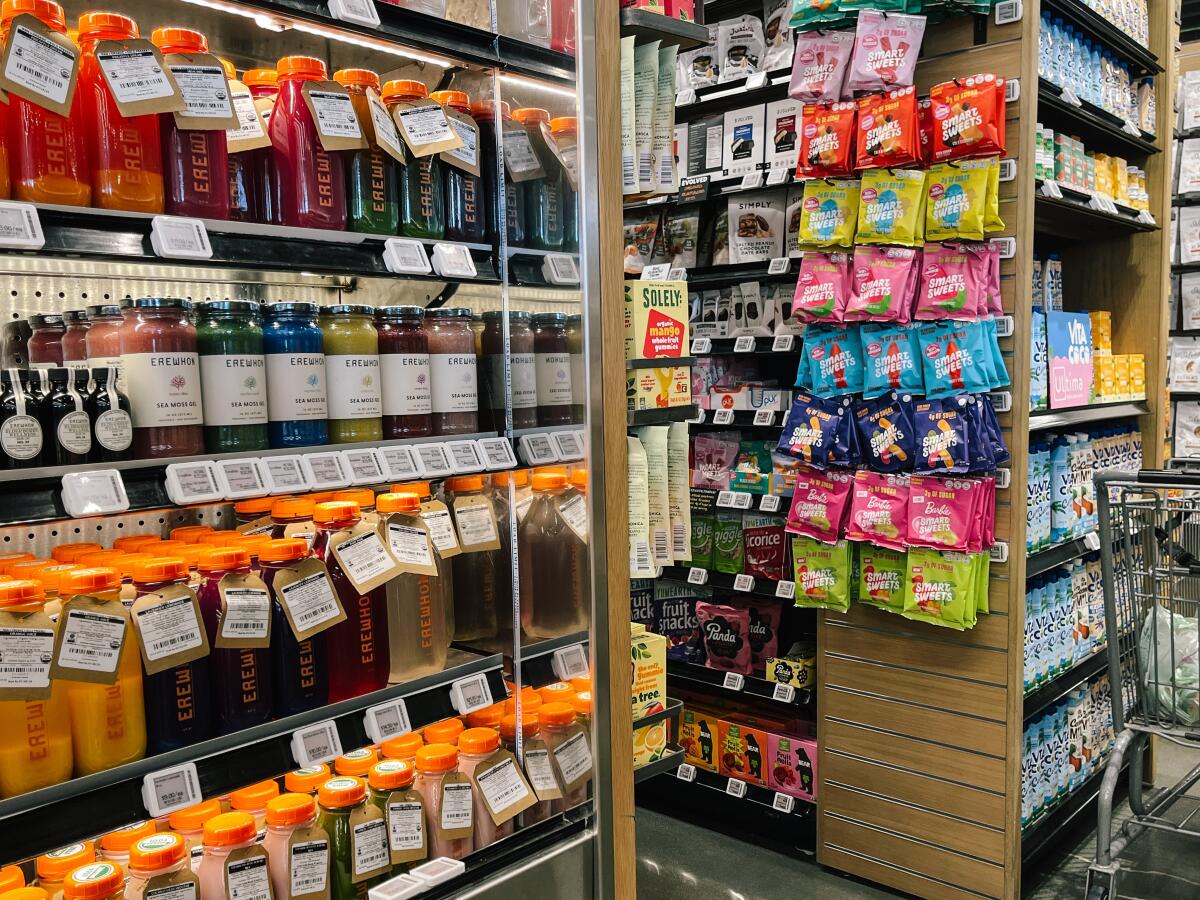
Erewhon now has 10 organic grocers around Los Angeles County and a devoted fan base of well-off, wellness-minded customers.
(Dania Maxwell / Los Angeles Times)
To build upon the buzz, Erewhon has branched out beyond selling groceries.
Its fast-growing private-label line now includes Erewhon-branded apparel, bags, candles, nutritional supplements as well as bath and body products.
And its membership program has grown to roughly 50,000 people who pay $100 to $200 annually for special pricing, perks such as free drinks and access to its “lifestyle collective,” an array of discounts from resorts, workout studios, spas and athleisure brands.
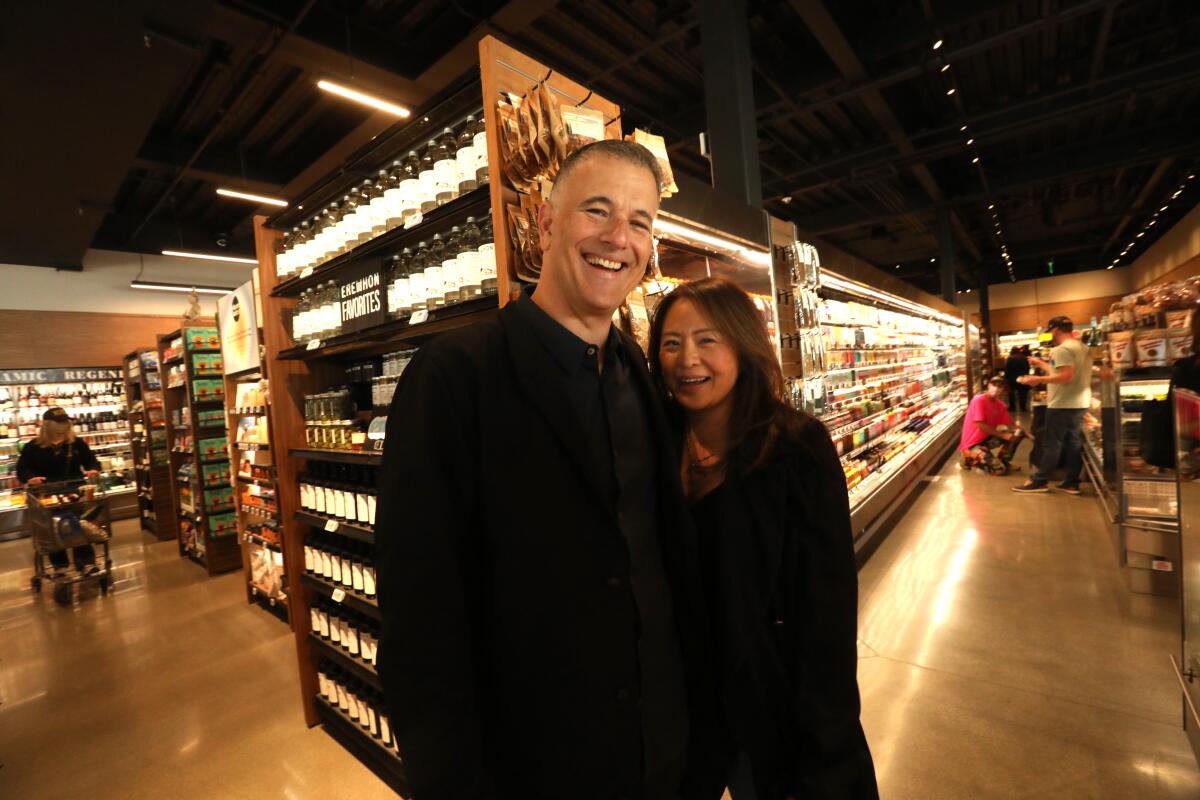
Erewhon owners Tony and Josephine Antoci at the Studio City store in 2021.
(Genaro Molina / Los Angeles Times)
The company recently expanded its shipping range for nonperishable items, such as a jar of sea moss gel for $88 or a logo hoodie for $185, to a total of 19 countries.
But fans from around the U.S. continue to push for physical stores in other regions, which Tony Antoci said is “a major focal point for us.”
A store in New York, he added, is “absolutely on our radar.” In order to do so, the company would first need to build an East Coast commissary similar to the one in Vernon, he said.
“For the immediate future, we’re focusing on Southern California.”

Business
As Netflix and Paramount circle Warner Bros. Discovery, Hollywood unions voice alarm

The sale of Warner Bros. — whether in pieces to Netflix or in its entirety to Paramount — is stirring mounting worries among Hollywood union leaders about the possible fallout for their members.
Unions representing writers, directors, actors and crew workers have voiced growing concerns that further consolidation in the media industry will reduce competition, potentially causing studios to pay less for content, and make it more difficult for people to find work.
“We’ve seen this movie before, and we know how it ends,” said Michele Mulroney, president of the Writers Guild of America West. “There are lots of promises made that one plus one is going to equal three. But it’s very hard to envision how two behemoths, for example, Warner Bros. and Netflix … can keep up the level of output they currently have.”
Last week, Netflix announced it agreed to buy Warner Bros. Discovery’s film and TV studio, Burbank lot, HBO and HBO Max for $27.75 a share, or $72 billion. It also agreed to take on more than $10 billion of Warner Bros.’ debt. But Paramount, whose previous offers were rebuffed by Warner Bros., has appealed directly to shareholders with an alternative bid to buy all of the company for about $78 billion.
Paramount said it will have more than $6 billion in cuts over three years, while also saying the combined companies will release at least 30 movies a year. Netflix said it expects its deal will have $2 billion to $3 billion in cost cuts.
Those cuts are expected to trigger thousands of layoffs across Hollywood, which has already been squeezed by the flight of production overseas and a contraction in the once booming TV business.
Mulroney said that employment for WGA writers in episodic television is down as much as 40% when comparing the 2023-2024 writing season to 2022-2023.
Executives from both companies have said their deals would benefit creative talent and consumers.
But Hollywood union leaders are skeptical.
“We can hear the generalizations all day long, but it doesn’t really mean anything unless it’s on paper, and we just don’t know if these companies are even prepared to make promises in writing,” said Lindsay Dougherty, Teamsters at-large vice president and principal officer for Local 399, which represents drivers, location managers and casting directors.
Dougherty said the Teamsters have been engaged with both Netflix and Paramount, seeking commitments to keep filming in Los Angeles.
“We have a lot of members that are struggling to find work, or haven’t really worked in the last year or so,” Dougherty said.
Mulroney said her union has concerns about both bids, either by Netflix or Paramount.
“We don’t think the merger is inevitable,” Mulroney said. “We think there’s an opportunity to push back here.”
If Netflix were to buy Warner Bros.’ TV and film businesses, Mulroney said that could further undermine the theatrical business.
“It’s hard to imagine them fully embracing theatrical exhibition,” Mulroney said. “The exhibition business has been struggling to get back on its feet ever since the pandemic, so a move like this could really be existential.”
But the Writers Guild also has issues with Paramount’s bid, Mulroney said, noting that it would put Paramount-owned CBS News and CNN under the same parent company.
“We have censorship concerns,” Mulroney said. “We saw issues around [Stephen] Colbert and [Jimmy] Kimmel. We’re concerned about what the news would look like under single ownership here.”
That question was made more salient this week after President Trump, who has for years harshly criticized CNN’s hosts and news coverage, said he believes CNN should be sold.
The worries come as some unions’ major studio contracts, including the DGA, WGA and performers guild SAG-AFTRA, are set to expire next year. Two years ago, writers and actors went on a prolonged strike to push for more AI protections and better wages and benefits.
The Directors Guild of America and performers union SAG-AFTRA have voiced similar objections to the pending media consolidation.
“A deal that is in the interest of SAG-AFTRA members and all other workers in the entertainment industry must result in more creation and more production, not less,” the union said.
SAG-AFTRA National Executive Director Duncan Crabtree-Ireland said the union has been in discussions with both Paramount and Netflix.
“It is as yet unclear what path forward is going to best protect the legacy that Warner Brothers presents, and that’s something that we’re very actively investigating right now,” he said.
It’s not clear, however, how much influence the unions will have in the outcome.
“They just don’t have a seat at the ultimate decision making table,” said David Smith, a professor of economics at the Pepperdine Graziadio Business School. “I expect their primary involvement could be through creating more awareness of potential challenges with a merger and potentially more regulatory scrutiny … I think that’s what they’re attempting to do.”
Business
Investor pleads guilty in criminal case that felled hedge fund, damaged B. Riley

Businessman Brian Kahn has pleaded guilty to conspiracy to commit securities fraud in a case that brought down a hedge fund, helped lead to the bankruptcy of a retailer and damaged West Los Angeles investment bank B. Riley Financial.
Kahn, 52, admitted in a Trenton, N.J., federal court Wednesday to hiding trading losses that brought down Prophecy Asset Management in 2020. The Securities and Exchange Commission alleged the losses exceeded $400 million.
An investor lawsuit has accused Kahn of funneling some of the fund’s money to Franchise Group, a Delaware retail holding company assembled by the investor that owned Vitamin Shoppe, Pet Supplies Plus and other chains.
B. Riley provided $600 million through debt it raised to finance a $2.8-billion management buyout led by Kahn in 2023. It also took a 31% stake in the company and lent Kahn’s investment fund $201 million, largely secured with shares of Franchise Group.
Kahn had done deals with B. Riley co-founder Bryant Riley before partnering with the L.A. businessman on Franchise Group.
However, the buyout didn’t work out amid fallout from the hedge fund scandal and slowing sales at the retailers. Franchise Group filed for bankruptcy in November 2024. A slimmed-down version of the company emerged from Chapter 11 in June.
B. Riley has disclosed in regulatory filings that the firm and Riley have received SEC subpoenas regarding its dealings with Kahn, Franchise group and other matters.
Riley, 58, the firm’s chairman and co-chief executive, has denied knowledge of wrongdoing, and an outside law firm reached the same conclusion.
The failed deal led to huge losses at the financial services firm that pummeled B. Riley’s stock, which had approached $90 in 2021. Shares were trading Friday at $3.98.
The company has marked down its Franchise Group investment, and has spent the last year or so paring debt through refinancing, selling off parts of its business and other steps, including closing offices.
The company announced last month it is changing its name to BRC Group Holdings in January. It did not immediately respond to requests for comment.
At Wednesday’s plea hearing, Assistant U.S. Atty. Kelly Lyons said that Kahn conspired to “defraud dozens of investors who had invested approximately $360 million” through “lies, deception, misleading statements and material omissions.”
U.S. District Judge Michael Shipp released Kahn on a $100,000 bond and set an April 2 sentencing date. He faces up to five years in prison. Kahn, his lawyer and Lyons declined to comment after the hearing.
Kahn is the third Prophecy official charged over the hedge fund’s collapse. Two other executives, John Hughes and Jeffrey Spotts, have also been charged.
Hughes pleaded guilty and is cooperating with prosecutors. Spotts pleaded not guilty and faces trial next year. The two men and Kahn also have been sued by the SEC over the Prophecy collapse.
Bloomberg News contributed to this report.
Business
Podcast industry is divided as AI bots flood the airways with thousands of programs

Chatty bots are sharing their hot takes through hundreds of thousands of AI-generated podcasts. And the invasion has just begun.
Though their banter can be a bit banal, the AI podcasters’ confidence and research are now arguably better than most people’s.
“We’ve just begun to cross the threshold of voice AI being pretty much indistinguishable from human,” said Alan Cowen, chief executive of Hume AI, a startup specializing in voice technology. “We’re seeing creators use it in all kinds of ways.”
AI can make podcasts sound better and cost less, industry insiders say, but the growing swarm of new competitors entering an already crowded market is disrupting the industry.
Some podcasters are pushing back, requesting restrictions. Others are already cloning their voices and handing over their podcasts to AI bots.
Popular podcast host Steven Bartlett has used an AI clone to launch a new kind of content aimed at the 13 million followers of his podcast “Diary of a CEO.” On YouTube, his clone narrates “100 CEOs With Steven Bartlett,” which adds AI-generated animation to Bartlett’s cloned voice to tell the life stories of entrepreneurs such as Steve Jobs and Richard Branson.
Erica Mandy, the Redondo Beach-based host of the daily news podcast called “The Newsworthy,” let an AI voice fill in for her earlier this year after she lost her voice from laryngitis and her backup host bailed out.
She fed her script into a text-to-speech model and selected a female AI voice from ElevenLabs to speak for her.
“I still recorded the show with my very hoarse voice, but then put the AI voice over that, telling the audience from the very beginning, I’m sick,” Mandy said.
Mandy had previously used ElevenLabs for its voice isolation feature, which uses AI to remove ambient noise from interviews.
Her chatbot host elicited mixed responses from listeners. Some asked if she was OK. One fan said she should never do it again. Most weren’t sure what to think.
“A lot of people were like, ‘That was weird,’” Mandy said.
In podcasting, many listeners feel strong bonds to hosts they listen to regularly. The slow encroachment of AI voices for one-off episodes, canned ad reads, sentence replacement in postproduction or translation into multiple languages has sparked anger as well as curiosity from both creators and consumers of the content.
Augmenting or replacing host reads with AI is perceived by many as a breach of trust and as trivializing the human connection listeners have with hosts, said Megan Lazovick, vice president of Edison Research, a podcast research company.
Jason Saldanha of PRX, a podcast network that represents human creators such as Ezra Klein, said the tsunami of AI podcasts won’t attract premium ad rates.
“Adding more podcasts in a tyranny of choice environment is not great,” he said. “I’m not interested in devaluing premium.”
Still, platforms such as YouTube and Spotify have introduced features for creators to clone their voice and translate their content into multiple languages to increase reach and revenue. A new generation of voice cloning companies, many with operations in California, offers better emotion, tone, pacing and overall voice quality.
Hume AI, which is based in New York but has a big research team in California, raised $50 million last year and has tens of thousands of creators using its software to generate audiobooks, podcasts, films, voice-overs for videos and dialogue generation in video games.
“We focus our platform on being able to edit content so that you can take in postproduction an existing podcast and regenerate a sentence in the same voice, with the same prosody or emotional intonation using instant cloning,” said company CEO Cowen.
Some are using the tech to carpet-bomb the market with content.
Los Angeles podcasting studio Inception Point AI has produced its 200,000 podcast episodes, accounting for 1% of all podcasts published on the internet, according to CEO Jeanine Wright.
The podcasts are so cheap to make that they can focus on tiny topics, like local weather, small sports teams, gardening and other niche subjects.
Instead of a studio searching for a specific “hit” podcast idea, it takes just $1 to produce an episode so that they can be profitable with just 25 people listening.
“That means most of the stuff that we make, we have really an unlimited amount of experimentation and creative freedom for what we want to do,” Wright said.
One of its popular synthetic hosts is Vivian Steele, an AI celebrity gossip columnist with a sassy voice and a sharp tongue. “I am indeed AI-powered — which means I’ve got receipts older than your grandmother’s jewelry box, and a memory sharper than a stiletto heel on marble. No forgetting, no forgiving, and definitely no filter,” the AI discloses itself at the start of the podcast.
“We’ve kind of molded her more towards what the audience wants,” said Katie Brown, chief content officer at Inception Point, who helps design the personalities of the AI podcasters.
Inception Point has built a roster of more than 100 AI personalities whose characteristics, voices and likenesses are crafted for podcast audiences. Its AI hosts include Clare Delish, a cooking guidance expert, and garden enthusiast Nigel Thistledown.
The technology also makes it easy to get podcasts up quickly. Inception has found some success with flash biographies posted promptly in connection to people in the news. It uses AI software to spot a trending personality and create two episodes, complete with promo art and a trailer.
When Charlie Kirk was shot, its AI immediately created two shows called “Charlie Kirk Death” and “Charlie Kirk Manhunt” as a part of the biography series.
“We were able to create all of that content, each with different angles, pulling from different news sources, and we were able to get that content up within an hour,” Wright said.
Speed is key when it comes to breaking news, so its AI podcasts reached the top of some charts.
“Our content was coming up, really dominating the list of what people were searching for,” she said.
Across Apple and Spotify, Inception Point podcasts have now garnered 400,000 subscribers.
-

 Alaska7 days ago
Alaska7 days agoHowling Mat-Su winds leave thousands without power
-

 Texas7 days ago
Texas7 days agoTexas Tech football vs BYU live updates, start time, TV channel for Big 12 title
-
Ohio1 week ago
Who do the Ohio State Buckeyes hire as the next offensive coordinator?
-

 Washington4 days ago
Washington4 days agoLIVE UPDATES: Mudslide, road closures across Western Washington
-

 Iowa6 days ago
Iowa6 days agoMatt Campbell reportedly bringing longtime Iowa State staffer to Penn State as 1st hire
-

 Miami, FL6 days ago
Miami, FL6 days agoUrban Meyer, Brady Quinn get in heated exchange during Alabama, Notre Dame, Miami CFP discussion
-

 Cleveland, OH6 days ago
Cleveland, OH6 days agoMan shot, killed at downtown Cleveland nightclub: EMS
-
World5 days ago
Chiefs’ offensive line woes deepen as Wanya Morris exits with knee injury against Texans


